Pollinators include birds, butterflies, moths, beetles, wasps, flies, and, most significantly, bees. They visit flowers to sip nectar or eat pollen, and they carry pollen grains from one location to the next. They help plants reproduce, which helps to maintain our ecosystems and create our natural resources. Let’s check out the top 20 garden plants that attract pollinators to your garden.
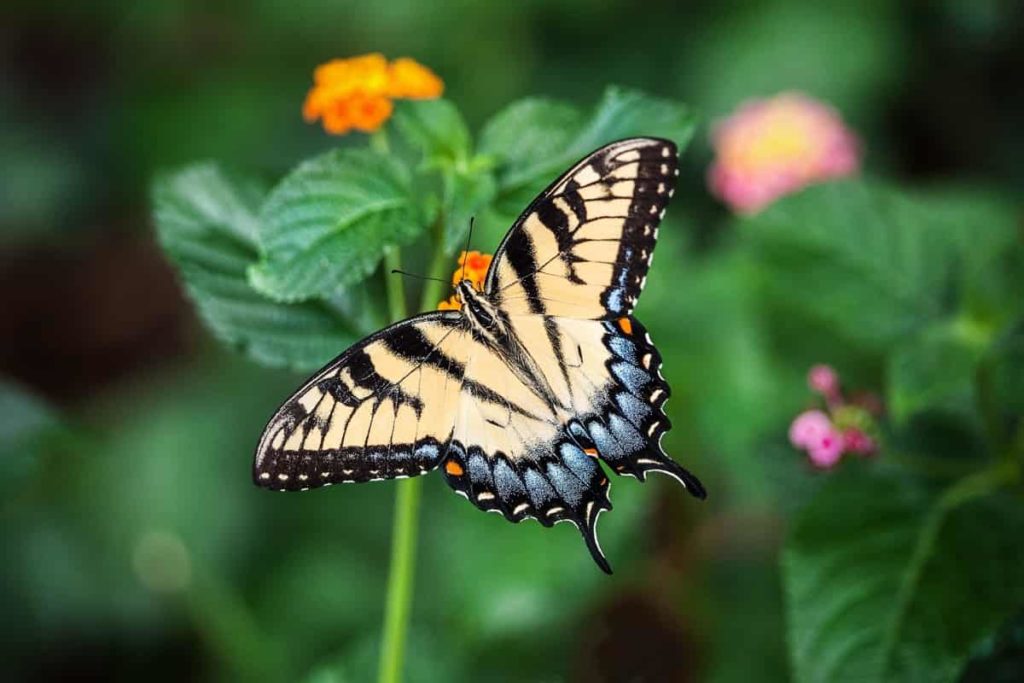
How do pollinators help gardens?
Pollinator gardens provide nourishment in the form of nectar and pollen to pollinators, ensuring that these critical creatures stay in the region and continue to pollinate our crops for sustained fruit and vegetable production. Pollinator gardens are the most adaptable, cost-effective, and long-lasting teaching tools on the market.
These gardens demonstrate the interconnected nature of our food ecology, as well as the important benefits pollinators, bring to human society. These gardens can be any size and contain a wide range of plants, such as flowers, shrubs, and trees. Pollinator gardens are much easier to set up and manage than food gardens, and they can serve as a foundation for future vegetable or butterfly gardens.
Top 20 garden plants that attract pollinators to your garden
Blue Wild Indigo
These are a group of enormous, long-lived perennials. Flowers and foliage provide a long season of appeal, and species change the height and width of the plants. Some species only reach a height of one to two feet.
Butterflies and bees are drawn to your yard by their aromatic flowers. Straight-up races are held for the flowers. To put it another way, floral spikes have a small stem that connects each bloom to the primary stalk. Their flower spikes, which are made up of pea-shaped blooms, can grow to reach 12 to 24 inches tall.
Bee balm
Bee Balm plants have a distinct look that helps you recognize them easily. They are primarily pink, red, and white in hue. Herbaceous perennials are the plants in question. Plants with non-woody stems are known as herbaceous. Because of its powerful smell and nectar, this plant attracts butterflies and bees. Because the plant grows and spreads quickly, it requires a large number of places to thrive. Because it is a perennial plant, it will add to the beauty of your garden for many years.
In case you miss this: How to Start a Backyard Garden from Scratch: A Beginner’s Guide
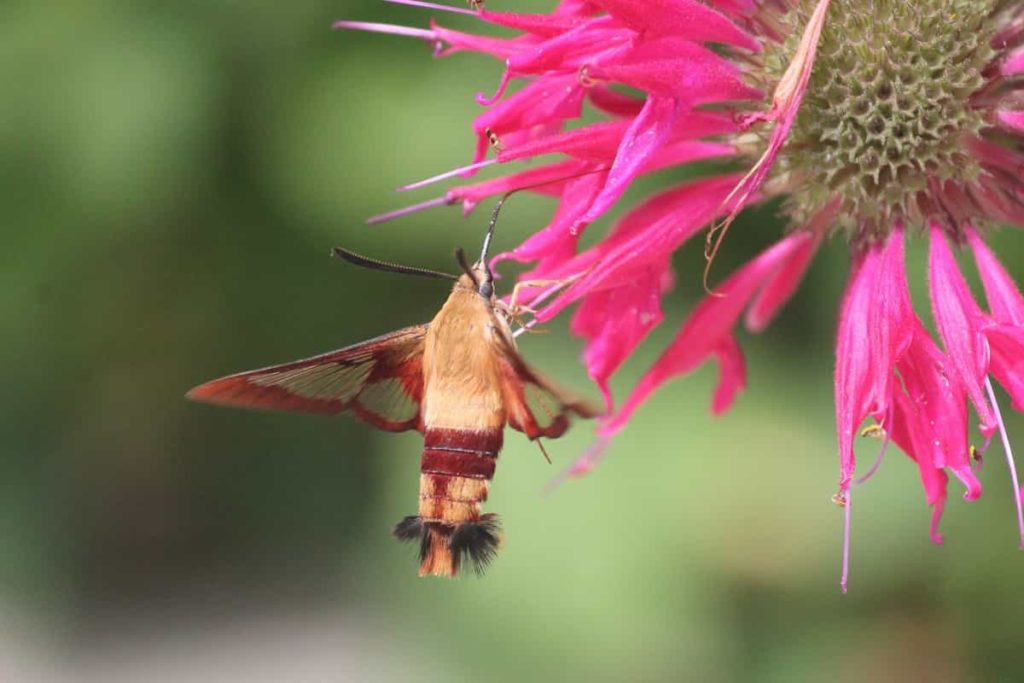
Buttonbushsh
The Common Buttonbush is a plant with twisted trunks that reaches 6-12 feet tall or occasionally higher. Their dark-green leaves are polished and lack vibrant fall colour. They’re also long-lasting, with white or light pink one-inch globes and strange blooms. After that, spherical piles of nutlets persist throughout the winter. When these plants are in bloom, honey bees and butterflies will flock to them. The apiary generally has a strong aroma at night while the bees are feeding on this plant.
Poppies
High pollen anthers are enjoyed by honey bees, solitary bees, and bumblebees. The pollen is released by bumblebees vibrating their bodies against the anthers of these plants. Poppies require a sunny location and bloom from May to June.
Monarda
Monarda is a beautiful long-blooming plant that attracts bees and hummingbirds if you reside in the proper region of the world. It should be planted in a bright location that receives only a little afternoon shadow. Because plants can be sensitive to powdery mildew, leave enough space between them. If powdery mildew is a recurrent problem in your garden, you might want to try species that are less susceptible to it.
In case you miss this: Amazing Gardening Ideas for Beginners
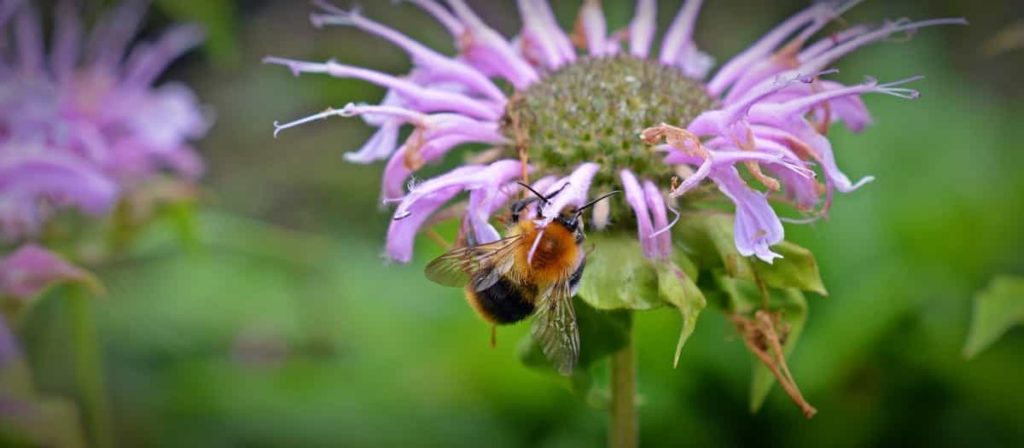
Golden Rods
Goldenrod is only attractive when it blooms, and its stem and leaves have a weedy appearance. Depending on the kind, they bloom anywhere from midsummer through late summer to October. However, this plant is tall and thin with delicate, golden flower spikes.
Goldenrods are one of the most important pollinator plants in the late season. Goldenrod nectar is typically imported in large quantities by honey bees and butterflies early in the season. Pollen is used by other bees to supply late-season nests. They’re generally thick and have a strong fragrance, and they granulate quickly.
Purple toadflax
Flowers from late May to June, and blooms for a long time – especially if the stems are trimmed before every little flower has gone to seed. They will then produce additional flower stalks, providing more feeding opportunities for bees. A beautiful, tall flower with pale pink or purple flower spikes. You’ll enjoy watching bumblebees and solitary bees climb the stem.
Lavender
It’s difficult to picture a bee garden without lavender! Lavender is one of the most effective plants for attracting bees. There are many options to choose from to ensure the longest possible display. Plant it near a sitting room so you can enjoy the scent while listening to the bees buzz!
Globe Thistle
The massive spiky blooms bloom in early summer and can continue for up to eight weeks. They’re stunning flowers with dark blue petals set in a spiky frame. The leaves are completely notched, with a dark green top and a silvery underside that is slightly fuzzy. Asia and Europe are the origins of the plants.
In case you miss this: How to Make Flowers Bloom Fast, More, Tips, Ideas and Techniques
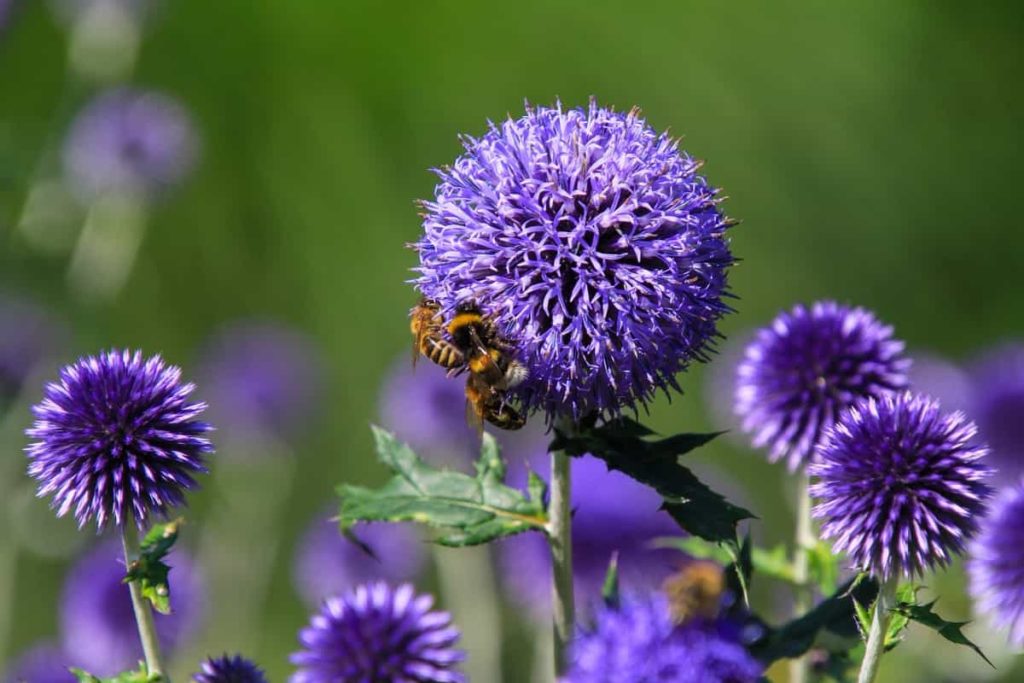
Globe Thistle attracts bees and butterflies because it provides much nectar. They are simple to raise from seed and will return year after year. Bees will flock to this mid-summer bloom, and it is not uncommon to see many varieties of bees and butterflies working together on a single flower head.
Floss flower
Floss Flower is a Mexican year-round blooming plant. The floss flower plant produces fuzzy blooms in rounded, compact flower heads, giving the yard an interesting blue floral hue. They may grow to be 12 to 39 inches tall under little shade.
The floss flower blooms from late spring to early summer, and its exceptional qualities make this blooming plant a welcome addition to outdoor planters. In late October, they provide great nectar for butterflies and bees. They are one of the final foods available to pollinators before the harsh cold puts everything to rest for the season.
Sea Holly
It thrives in well-drained soil and grows in sandy and dry soil conditions, so if you live near the seaside, this might be the perfect plant for your garden. From June to August, plant it in full light and watch the bees settle on it.
Strawflowers
This attractive blossom attracts pollinators. There are many gorgeous, vibrant hues of orange and pink to choose from, and the blossom may be preserved and used in dried floral arrangements.
Fleabane
In the spring and early summer, you may have noticed this lovely daisy-like wildflower in the yard, against buildings and along roads. Fleabane flower heads range in colour from white to pinkish purple. Trimming the plant is a simple way to keep it under control. Their simple reproductive motions, along with their beauty, make it an ideal weed—and a vital component for pollinators such as bees and butterflies.
Daylilies
The coolest of all the flowering perennials are daylilies. The plants are fast-growing and have a lengthy lifespan. They bloom in practically all soil types, can grow in the sun or the shade, and are rarely bothered by insect pests or disease. Numerous pollinators, especially butterflies and bees, are attracted to daylilies. Part of their notoriety stems from the cup-like form that allows these small living beings to collect the nectar they require to blossom.
In case you miss this: Organic Vegetable Gardening for Beginners
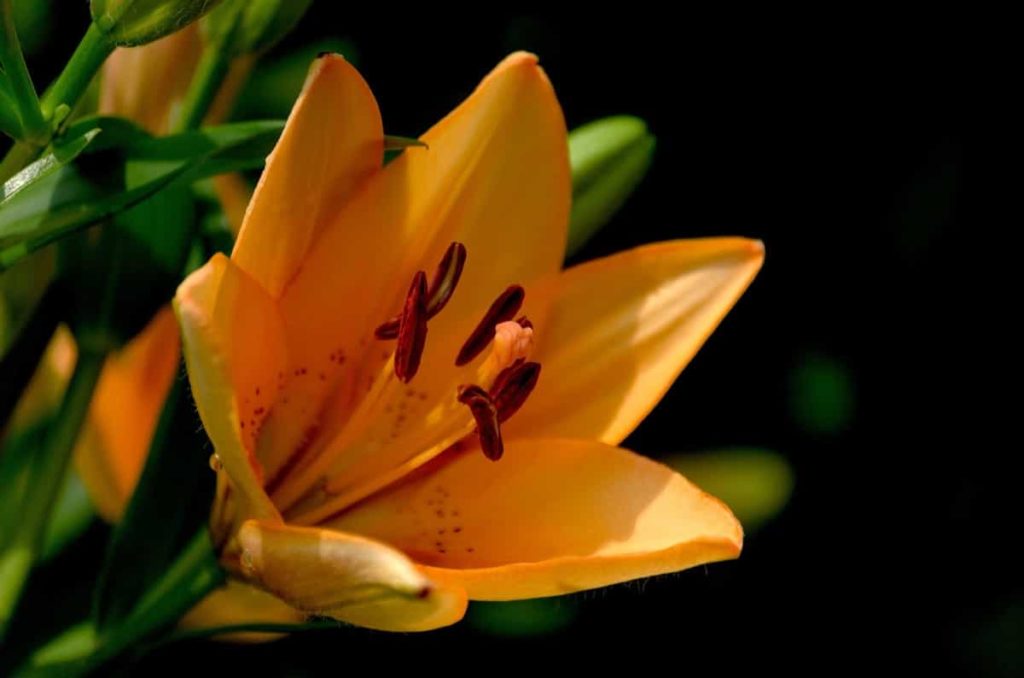
Wallflowers
Wallflowers are a favorite of bees and butterflies. There is no need to worry about poor soils – or even no soil at all – when it comes to wallflowers. They prefer full sun, but can also tolerate some light shade. Often, it’s called a short-lived perennial or biennial. Plant seeds in June to produce plants that can be bed out in August/early autumn. Flowers will bloom the following spring. You can plant them for a lovely, scented display humming with bees.
Sunflowers
Sunflowers thrive in containers and garden beds alike. Until frost, they grow multi-branching and bloom continuously up to 4-5 inch flowers. The hue of these flowers ranges from creamy to brilliant yellow to deep gold to bicolor red. All pollinators, notably honeybees and bumblebees, love these blooms. These grow to be 4-5 feet tall and 2-3 feet broad. They require direct sunlight to flourish.
Beach Aster
Flowers bloom from late May to June and bloom for a long time. It is a Fantastic, low-growing evergreen perennial, ideal for sandier soils and drier places in the garden. It’s great for covering the ground.
When a handful of them are fully bloomed, you’ll see a swarm of bees grazing on the open blossoms one day. Bumblebees are particularly attracted to the blooms, although honey bees and solitary bees will also approach. Although it may take little shade, it loves full sun to attract a large number of bees.
Daisies
Pollen is collected by a variety of bees, including the orange-legged furrow bees. These bright blooms are simple to grow. Remember to consider the height of your plant while placing it in your border or container, depending on the type you chose. More information on brilliant daisies and bees may be found here.
Clove Pink flowers
Clove Pink flowers are a good choice for gardeners with limited space and sunny regions. The plants’ opaque feathery structure is complemented by the enticing, perfumed blossoms, which have a long herbal history – both in medicine and as an edible adornment and flavoring. The plant has a well-organized structure before flowering, and once it blooms, it settles into a stable state with small fragrant flowers that attract bees and butterflies.
Cornflowers
These wildflowers are easy to grow, drought-tolerant, and adaptable to a variety of soil types. From June through September, the plant blooms. Remember to plant in broad sunlight and well-drained soil. Cornflowers are hardy and blossom for a long time. Their blooms are often blue, pink, yellow, white, or different shades of purple, and they are important suppliers of nectar and pollen in most locations. Blue and white-flowered flowers attract bees in particular.
In case you miss this: Top 20 Flowers To Grow In Aquaponics

Frequently asked questions
How do you induce pollination?
To encourage pollen release, gently swab the interior of each flower with a tiny paintbrush or cotton swab, or gently wipe the inside of each flower with a little paintbrush or similar kind of thing to shift pollen into the pistil, which is the central section of the flower.
What is the favourite flower for bees?
The bee balm flowers are greatly adored by bees. North Carolina is home to a variety of bee balm plants.
What flowers attract bees the most?
Bee balm, Daisy, Dandelion, Goldenrod, Lavender are some of the plants that attract the pollinators the most.
- Broccoli Seed Germination and Selection
- Asparagus Seed Germination and Variety Selection
- Seasonal Flower Gardening: Best Practices for Spring, Summer, Fall, and Winter
- How to Grow Hibiscus from Flower
- Plantation Ideas for Home Decoration: A Beginners Guide
- Flower Garden Designs and Layouts for Beginners
- Planting and Spacing Techniques in Papaya: A Beginner’s Guide
- Growing Gold: Essential Techniques for Planting Pineapples
- How to Make Kalanchoe Plant Bushy: Home Remedies and Solutions
- 11 Reasons Why Your Gardenia is Not Blooming: Home Remedies and Solutions
- Eco Elegance: The Guide to Designing a Drought-Tolerant Landscape
- Gardening on a Slope: Strategies for Hillside Landscaping
- Nourish and Flourish: Top Organic Mulches for Thriving House Plants
- Everything You Want to Know about Indian Mogra Flower: Discover Uses and Growing
- Green Thumb Success: Expert Tips for Cultivating Greenhouse Pumpkins All Year Round
- Maximize Growth & Flavor: The Ultimate Guide to Companion Planting in Herb Gardens
- How to Control Rhododendron Problems Naturally: Home Remedies and Organic Ways to Fix Them
- Natural Magic: The Remarkable Benefits of Cinnamon for Plants
- Best Steps to Revive Dying Tulip with Natural and Organic Treatment
- 10 Reasons Why Your Angel Trumpet is Not Blooming: Remedies and Treatment
- How to Fix Periwinkle Leaf and Flower-Related Problems: Natural Remedies and Solutions
- How to Fix Zinnias Leaf and Flower Problems: Discover Natural and Home Remedies
- Organic Steps to Induce Lemon Tree Flowers: A Comprehensive Guide
- Bloom Booster: Crafting the Perfect Homemade Bougainvillea Fertilizer
- Optimizing Growth: A Guide to Applying NPK Fertilizer for Potted Plants
- 10 Best Homemade Fertilizers for Rubber Plant: DIY Recipes and Application Method
- How to Boost Female Pumpkin Flowers: Effective Steps for More Flowers and High Yields
- Transform Your Indoor Garden: Top Benefits of Pink Salt for Houseplants
- 10 Best Homemade Fertilizers for Peacock Plants (Calathea): Easy DIY Guide
- Unlock Blooms: 9 Reasons Why Your Potted Chrysanthemum is Not Blooming
- 8 Reasons Why Your Potted Hibiscus is Not Blooming: Fix it with Simple Solutions
- Unlock Blooms: 9 Key Reasons Your Potted Frangipani Won’t Flower
- 10 Reasons Why Is My Ice Plant Not Blooming: Remedies and Treatment
- 10 Reasons Why My Potted Hydrangea Not Blooming: Treatment and Remedies
- 10 Reasons Why is My Wisteria Not Blooming: Remedies and Treatment
- 10 Reasons Why is My Goldfish Plant Not Blooming: Remedies and Treatment